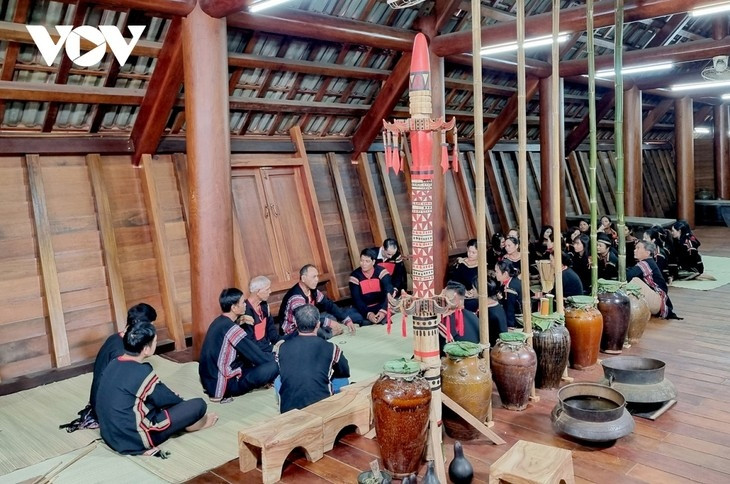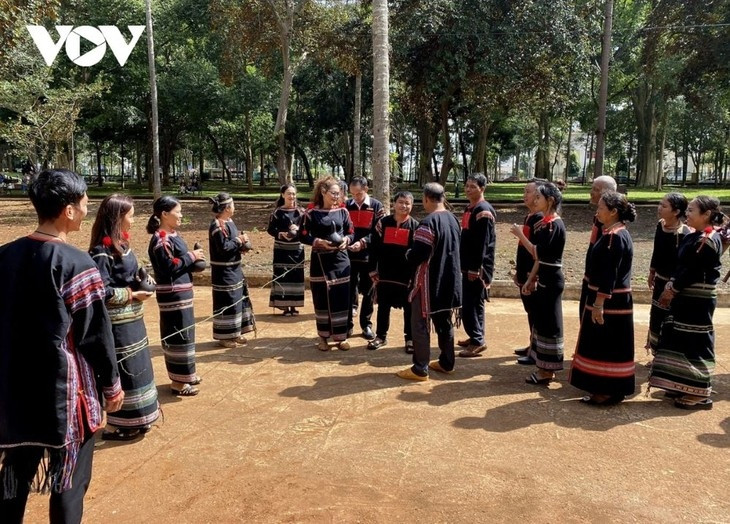

The bride's family is responsible for preparing betrothal gifts, and the groom's family has the privilege of asking for gifts. Before getting married, the bride lives with the groom’s family for a certain period. After the wedding, the groom goes to live with the bride’s family.
In the final days of the year when the coffee has been harvestedand the other farm work is finished,the parents of H Rin Bkrong of Tong Ju village, Buon Ma Thuot city, asks an uncle to go to the in-laws’ house to welcome their daughter and son-in-law back home.
Three years ago, H Rin Bkrong fell in love with a young man and asked her uncle to represent her family in making a marriage proposal. When the groom's family said yes, the two families agreed that H Rin would live with the groom's family for 3 years.
Villager H Yam Bkrong said that "staying as a daughter-in-law" tests a bride's loyalty, modesty, and tolerance for married life.
“When a girl becomes a bride, she should show modesty and diligence. She should wake up early in the morning to fetch water and prepare breakfast for the whole family before going to work. That will assure the husband's family that they have a diligent and hard-working daughter-in-law. Then they will feel more secure about having their son live with his wife's family," said Bkrong.
According to Ede customs, the girl lives with her husband's family for 2 to 3 years. Depending on the bride’s family’s wealth, the groom's family will ask the bride's family to give them some gifts to show their gratitude to the groom’s parents for raising him.
H Bluen Nie of Tong Ju village said the wedding gifts should include copper bracelets, brocade blankets, and some pigs or cows. The more educated and higher status the man, the more valuable the wedding gifts he can request.
While the groom's family has the right to request gifts, the bride's family has the right to negotiate a reduction, said H Bluen Nie.
“The groom’s family do not want to burden the bride. They just want to boost their son’s status and reputation before he goes to live as a son-in-law. Later, when the young couple are living on their own, they will take care of and support both families,” H Bluen Nie explained.

After the "staying as a daughter-in-law" period, if the man changes his mind and does not want to marry the woman, his family invites the woman’s family to come to hear their decision. That rarely happens. But if it happens, the groom's family must return twice the amount of gifts they received and prepare a big cow or pig to apologize to the bride's family.
Normally, the groom’s family accepts the daughter-in-law and allows their son to move in with the wife’s family. The groom’s family prepares a vase of liquor and a pig for the farewell ceremony.
The bride’s family prepares all the items that the groom’s family has asked for. Then the bride’s relatives come to the groom’s family’s house to take the young couple home.
On the way home, the groom's procession will be teased and stopped by groups of young men who are the bride's friends and siblings. The members of the procession must respond properly and give them gifts of copper bracelets to show the couple’s determination to marry.
The Ede believe that if the couple encounter difficulties and obstacles on the way to the bride’s house, the marriage will overcome all challenges in the future.
Arriving at the bride's house, the two families conduct rituals to recognize the couple. A pair of copper bracelets is worn by the young couple to remind them to be faithful.
If one of them returns the bracelet, changes his or her heart, or does anything wrong in the marriage, he or she must compensate by paying twice the amount of the wedding gifts. After the rituals, both sides congratulate and convey best wishes to the couple.
Y Quoc Nie, on the first day of living with his wife's family, said, “I just completed the bridegroom procession. The elder people’s teachings and instructions have been very meaningful. Now I understand our group’s customs and norms which should be preserved for future generations.”
Today many Ede families in Dak Lak organize modern wedding ceremonies. But they still observe some traditional rituals. Y Bhiu Byă of Tong Ju village says the wedding process has seen changes to adapt to modern life.
“The custom began a long time ago, but today not many families follow the custom of “staying as a daughter-in-law”. The two families can substitute a gift of 2 or 3 taels of gold for 2 or 3 years staying with the groom’s family,” Y Bhiu Byă said.
Although the tradition has changed, the best features of the Ede wedding are still maintained.
Source: VOV